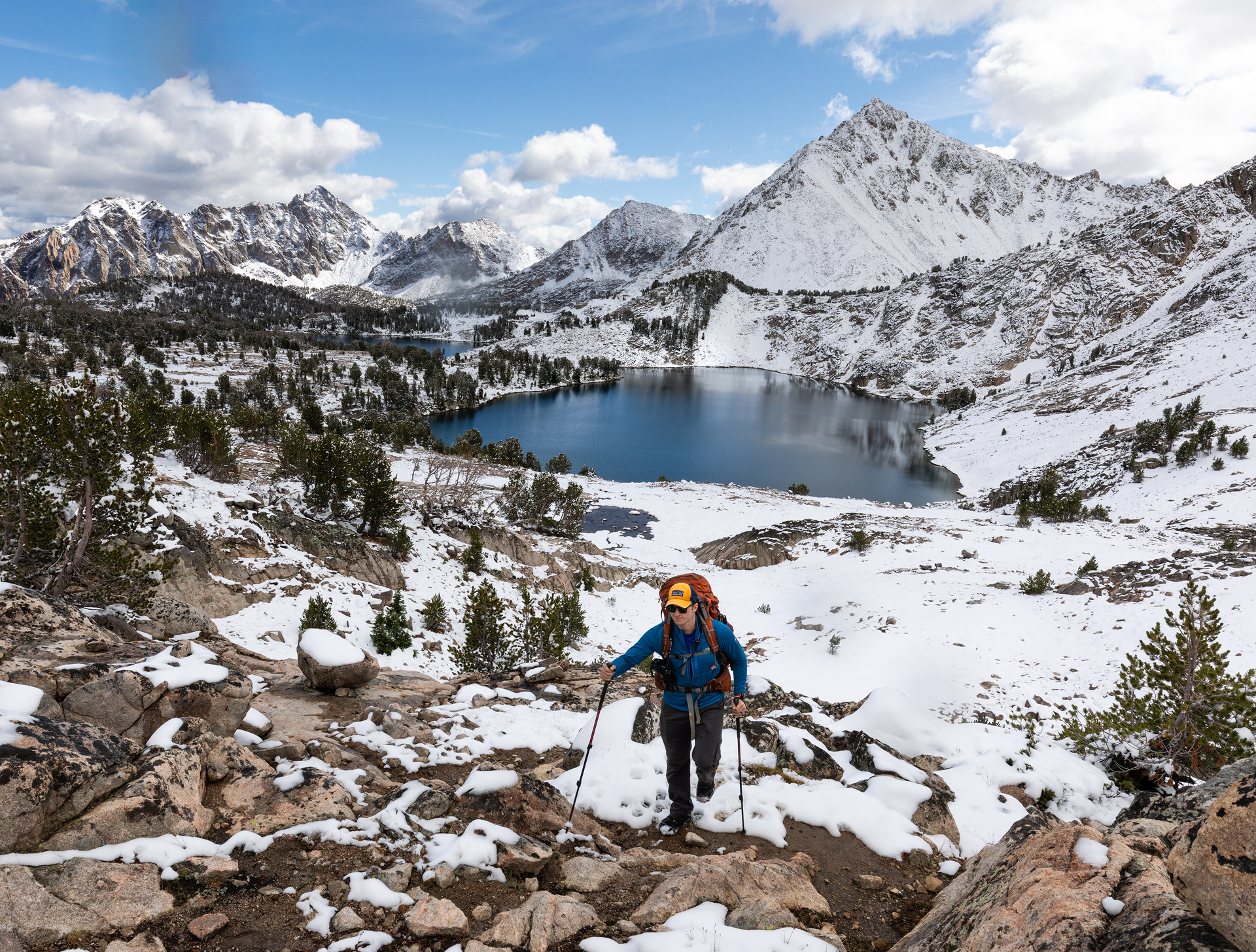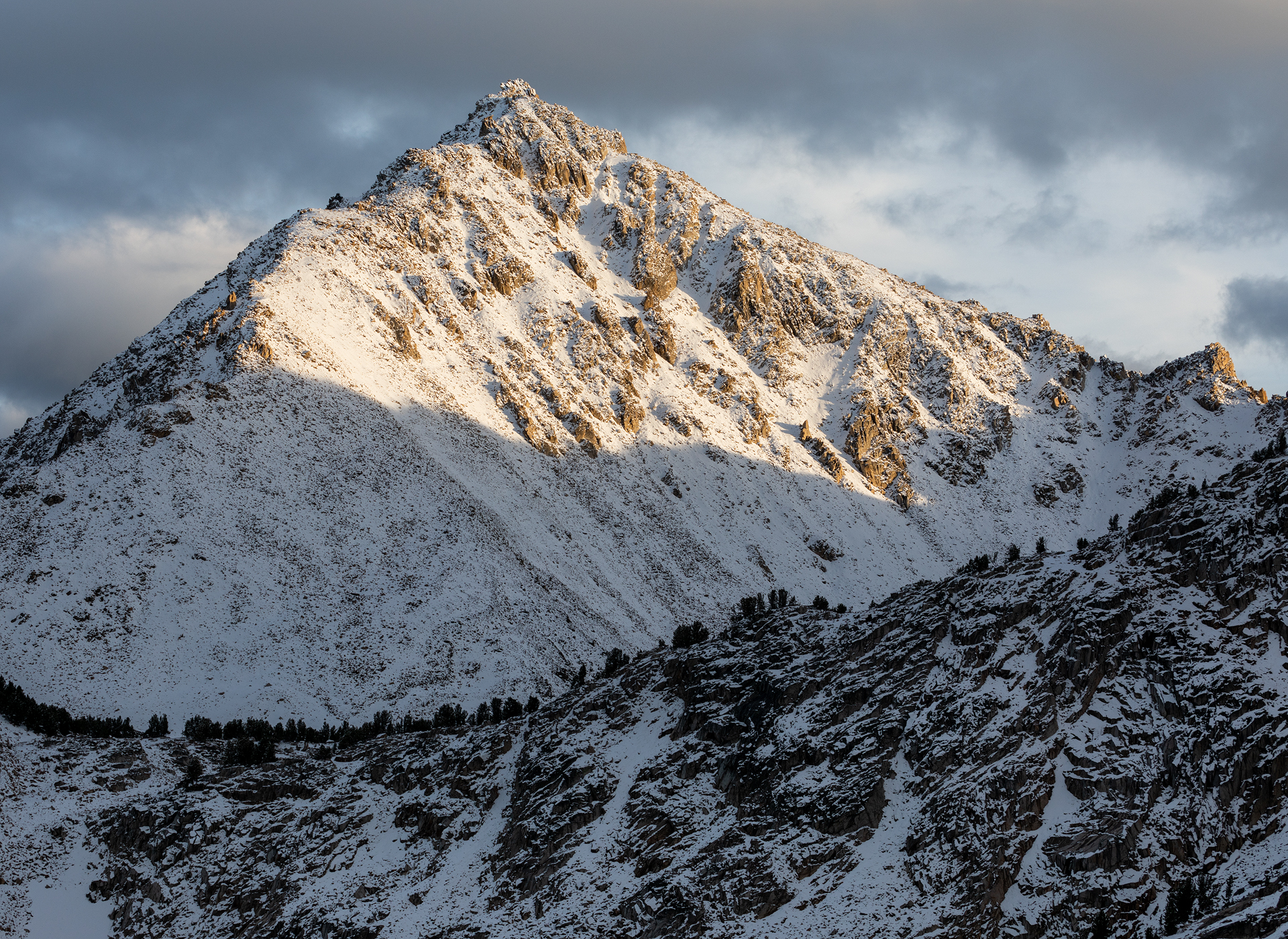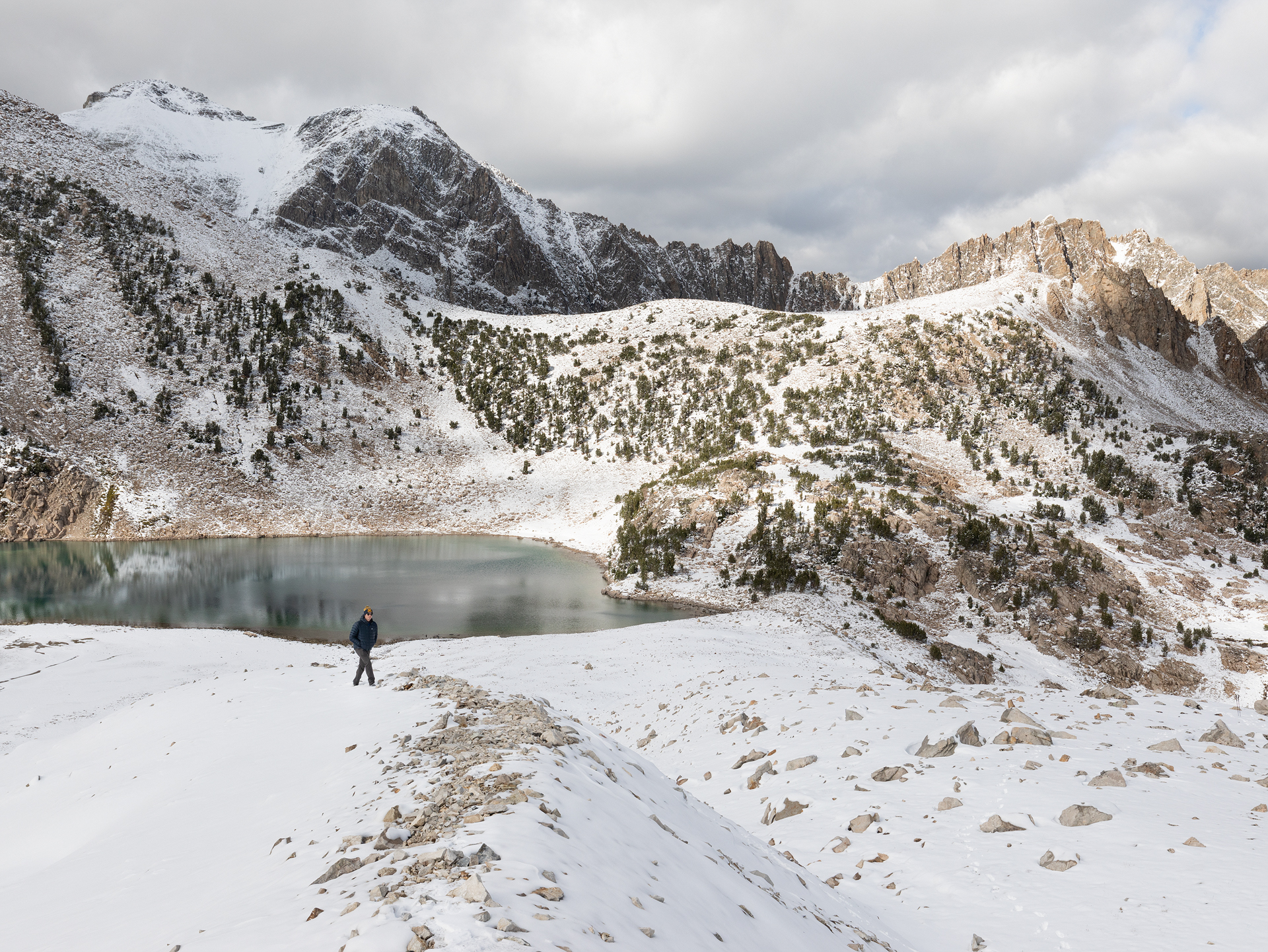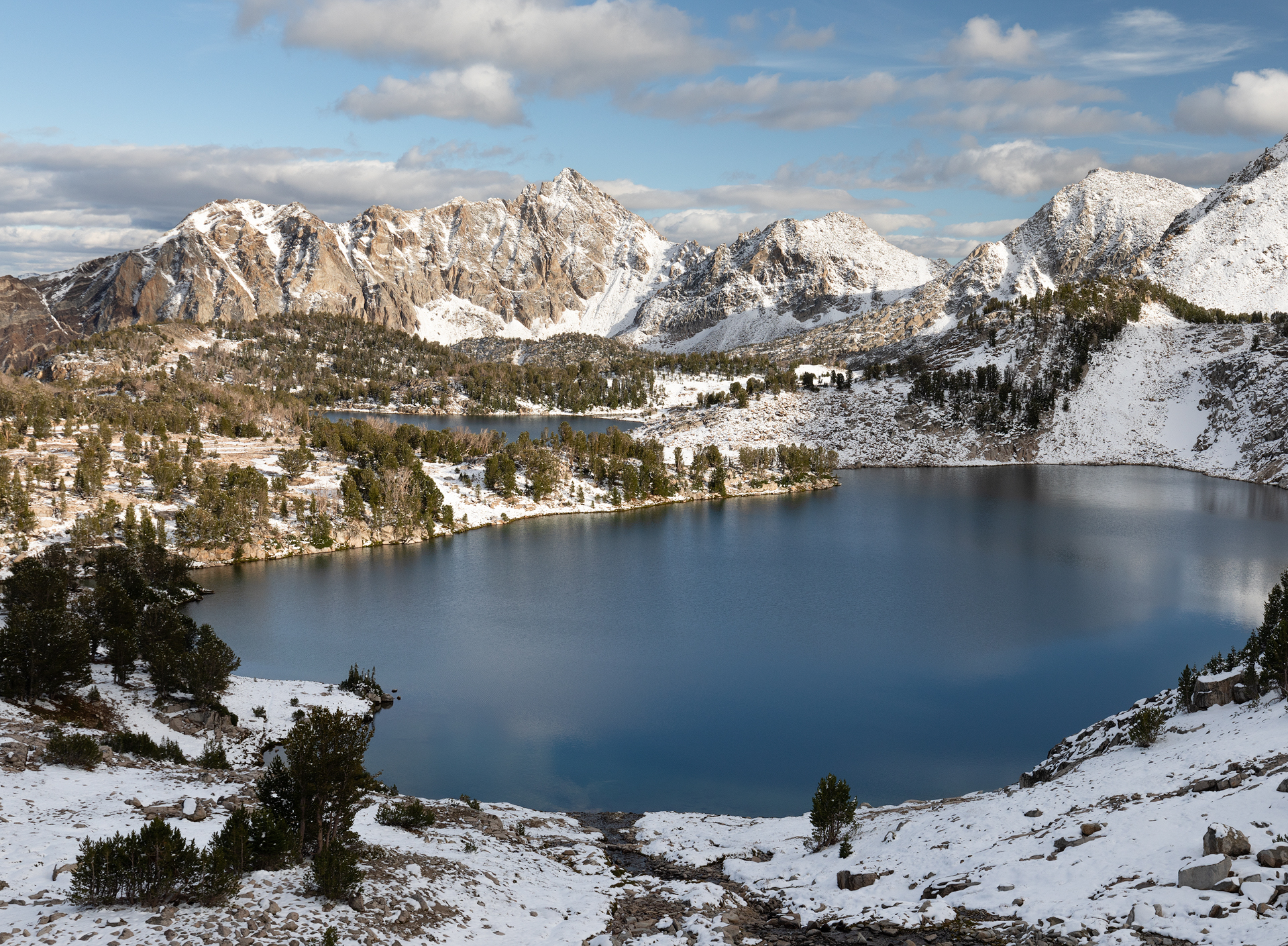Fall Meets Winter in Sawtooth National Forest
9/20/19 - 9/22/19
I read the route description in the guidebook yet again. Douglas Lorain writes: “Ahead of you is one of the supreme alpine wonderlands in Idaho, and, in fact, it is probably the equal of any alpine area in the country—and I’ve been to most of them.” Lorain ranked the Big Boulder Lakes in Sawtooth National Forest 10/10 for scenery and his words in the book elicited imagery of sparkling lakes nestled beneath jagged mountains. However, as we sat in our rental car at the trailhead, and listened to the rain beat against the roof, Alex and I wondered if the current conditions would allow us to see any of the splendor described in the book or if we would be subjected to a miserably wet three days on the trail.
The minutes ticked by and neither of us moved to get ready for the hike. According to the forecast I had been checking incessantly, our first day would indeed be rainy—and perhaps even snowy at higher elevations—but the second and third days looked like they would be dry. As we looked out the rain dappled windows, surrounded by heavy, overcast skies, imagining this area dry was a tough exercise.
We weighed all of our options and after an hour of hemming and hawing we finally made a decision: We would start the hike. We mustered the willpower to get out of the car and finish packing. The cold air immediately cut through my fleece and I shivered. The trailhead sits at about 7,200’ and our hike would take us over 10,000’. We had hoped that a mid-September hike would still be mild, but it was apparent that we were be in for a cold hike. We always pack our warmest gear, especially in the shoulder season, so we were prepared for, but not necessarily looking forward to the cold.
We registered at the trailhead (no other permits are required for this hike) and as I wrote down our information in the log I noticed that no one had registered in the past five days. I entered our names, intended destinations, and estimated date of exit and then we officially hit the trail. We hiked in silence, with our jackets zipped all the way up and our hoods pulled tightly around our faces to keep out the rain.
After about a mile of hiking we ran into two hunters heading toward the trailhead, one of them was wearing glasses that were so covered in water droplets I wondered how he could see. We asked about conditions and they told us the trail was muddy and slick. They looked eager to continue hiking, and we didn’t blame them, so we didn’t ask any more questions and the hunters hurried along.
As the miles passed by beneath our feet the clouds teased us. We would look up intermittently and see blue skies fighting their way through the clouds, but they could never win the battle.
We ran into a third hunter after an hour. He was on horseback and paused to talk with us. We asked him how his time was and he said the previous night was “absolutely miserable”. We told him our plan to stay out the next few days and he chuckled. He pushed his horses ahead and as he was riding down the trail he called back to us, “good luck with that.”
Both of the interactions we had with other hikers left us second-guessing our decision. Our nerves were further shaken when we reached the snow line and the trail became more difficult to follow. And then, when we thought the situation couldn’t get much worse, fat snowflakes began falling on us and visibility diminished. We decided to take an extended break and reassess conditions. We were only about a mile from our destination for the night—Island Lake. If the conditions continued to deteriorate we planned to set up camp where we were. Until then we waited it out underneath the cover of a tree, huddled in all of the layers we brought. Luckily, our wait wasn’t long because just as quickly as the snow started, it stopped. The clouds broke and sun shined down on us. Hiking in the shoulder season can be wild!
We marched on toward camp. It may have only been a mile to camp, but as we hiked the weather changed yet again and by the time we made it to Island Lake we were caught in another flurry. This squall looked like it would last longer so we decided to set up our tent and dry off as quickly as possible. We set up the tent in record time, changed into fresh, dry clothes and snuggled into our sleeping bags. As we lay in our cozy cocoons we listened to the snow fall softly on the tent. I had to admit it was a soothing sound. We weren’t sure what the evening or night would bring in terms of snow accumulation so we were happy to be safely within the confines of our tent.
We took a nap and by the time we woke up the snow had stopped. The clouds were still low and looked swollen with precipitation, but no snow fell for the remainder of the trip. We went to bed early the first night, the clouds were still too thick to allow for any sort of light at sunset. Instead, the landscape around us slowly faded to black.
The night was long. The fall equinox was only two days away, which meant we experienced nearly 12 hours of darkness. The night was black, and cold and I slept poorly, waking every hour or so to reposition myself. Even after the sun fully rose at 7:40am we stayed in the tent and continued to doze. We stayed in the tent until nearly 9am, a first for us!
The weather looked much more promising on the second day. The clouds were higher, they were wispy, and there were nearly equal amounts of blue sky and clouds. The planned mileage for day two was short—only four miles—so we took our time packing up camp and enjoyed the scenery around Island Lake. The landscape looked entirely different than the previous day. The morning light shines brilliantly on the peaks surrounding the lake and the lake twinkled a gem-colored green.
Eventually we began the hike to Sapphire Lake. To get to this next spot we had to retrace our steps from the Island Lake trail to a junction in the main trail about one mile back. The morning sun had already started to melt the snow on the trail so it was much easier to follow. However, after about a half an hour of hiking we still hadn’t reached the junction, which seemed wrong. Our watches showed we had hiked 1.25 miles already, we should have definitely seen the trail split. We established our bearings and realized that we had flew past the junction and were now heading back toward the trailhead. Feeling defeated we turned around and began trudging back uphill, on the lookout for the sign. A quarter mile later we saw the sign. It blended in well and was virtually impossible to see from the direction we hiked down from Island Lake. This time, we took a right at the junction, and headed toward Walker Lake.
The trail was snowy and there were no human footprints. We saw elk prints and even a set of bear prints, but still no other humans shared the trail with us.
After Walker Lake, the official trail runs out. There are a few faint social trails but any trace of those were buried under the fresh snow. We pulled out our topo map and began to plot our route up and over a snowy boulder field.
Shortly after entering the boulder field, we stopped to check the weather on our Garmin InReach. We were confident that we could hike up and down the boulder field in the current conditions, but if more snow swept in overnight we were worried it would make the boulder field unnavigable. We threw down our packs, pulled out the InReach, and requested a weather update. Ten minutes later the forecast came through. The remainder of the day was forecast to be partly cloudy, but the clouds were expected to clear overnight. Feeling buoyed by the forecast we put our microspikes on and carefully navigated the slick boulder field.
It was slow-going and mentally draining as we worked our way through the rocks, focusing all of our effort on placing each foot in precisely the right spot. Eventually, we made it over the ridge and received our first glimpse of the Big Boulder Lakes. They far surpassed my highest expectations. Lorain’s claim that they are some of the finest alpine scenery in the country, while a bold boast, is valid. It was a wonderland. The lakes sat like gems below snow-dusted peaks.
We quickly made our way into the basin and began searching for a place to set up camp. We found a flat, snowy expanse in between Sapphire Lake and Cirque Lake that offered a beautiful view of the entire basin. We set up the tent there and then began to explore. The clouds danced through the sky and threw the landscape in and out of shadows. A few of the clouds looked worrisome, but before they could release any rain, they floated by and dissipated.
It was tough to know which direction to head to first as the entire basin was spectacular, but we headed to a ridge that looked to have a high perspective of the area. As the sun sank lower, the clouds turned to the color of honey and the peaks were drenched in warm light. The scene continued to grow more vibrant and colorful as time passed, the clouds transitioned from gold to a bright pink and alpenglow dyed the tallest peaks orange after the sun finally sank beneath the horizon. Finally, the scene glowed purple as the white snow reflected the lavender skies.
After the light faded, the air turned brisk and we retreated to the tent. The night was frigid—one of the coldest we’ve experienced in awhile—the temperatures dipped into the mid-20s and when I awoke I found my shoes had frozen solid overnight. I had to breathe into them for over ten minutes before they thawed enough that I could jam my feet into them and head to the shore of Cirque Lake to capture the first rays of light on the surrounding peaks.
After we enjoyed the clear and crisp sunrise we began to pack up camp. We had a long day ahead of us. First, we had to hike all the way back to the trailhead and then we had to drive five hours to Boise to catch a 9:30pm flight.
We hit the trail, bound for the car!
While I started the morning with icy shoes, it wasn’t long until we were cooking under the morning sun and were shedding our layers. The sun was beating down and there wasn’t a cloud in the sky. The Garmin InReach’s forecast was spot on.
While I was concerned about descending the snowy boulder field—it looked so long and each step was such a process—the hike down went smoothly. We descended in just over half an hour and I was relieved when I stepped off the last slick rock onto flat ground. The hardest part was behind us!
After the boulder field we had about seven more miles to hike to the car. The conditions had changed so much since our first day that most of the trail was unrecognizable. Areas that were shrouded in clouds and snow on the first day were completely revealed as we made our way to the car. The snow at the lower elevations had completely melted and we could now see that the leaves and foliage were starting to change into their autumn colors. This was the fall we had been searching for! We enjoyed these scenes, on the real first day of fall, for the final few miles.
Even though the trip didn’t go quite as we had expected, we are glad we made the decision to push through the precipitation and cold. The fresh snow dusting the landscape was spectacular to witness. Snowy peaks surrounding not-yet-frozen lakes are my favorite mountain scenes and I was grateful to spend two days enjoying those exact views on this trail. Idaho is a place that I fall more and more in love with every time I visit. I already can’t wait for our next Idahoan adventure!




















